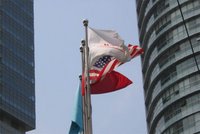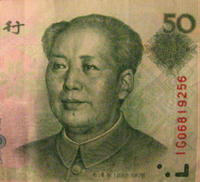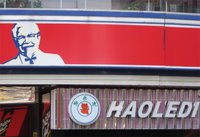
I'll admit, I love the old Communist propoganda. In form, not function, of course - it's hard to be a big fan of the Cultural Revolution, or the Russian Soviet propoganda machine. The art of Communism, however, with its goal of conveying ideals to the public rather than impressing a sense of artiness to an elite, is much more approachable in theme and subject than most Modern Art. And of course the bold design aesthetic is striking - particularly if you compare it to, say, the look of American posters from before Photoshop and desktop publishing. And I can't deny, there's a certain kitsch appeal to the simple themes, often out-dated and generally over-dramatized. Have a look at Stefan Landsberger's Chinese Progoganda page.
I realize that the glory days of this propoganda is in the past. However I expected at least some visible remnants. Maybe a Mao here or there, some kind of statues, even a few posters. Instead, I was surprised to see that state propoganda is not to be seen on the city streets. For the most part, not even a flag - I don't have to say how common state flags are in the United States, along with reminders of 9-11, signs in front of minority-owned businesses reminding people that they're also American (so please don't throw a rock through the window), and crucifixes.
 In contrast, take XinTianDi (please). It's a trendy international-esque shopping center with a lot of popular bars, all of which are secretly desperately uncool. I'd been a couple of times before I realized it also houses the original meeting-place of the Chinese Communist Party. I went in to have a look, and was surprised to see a straightforward presentation of the various events that culminated in the Communist revolution. Mao Zedong, one of the thirteen attendees, was given one (1) photograph. There wasn't even a Chinese flag to be seen, although there was a flag of the Communist Party prominent in the lobby.
In contrast, take XinTianDi (please). It's a trendy international-esque shopping center with a lot of popular bars, all of which are secretly desperately uncool. I'd been a couple of times before I realized it also houses the original meeting-place of the Chinese Communist Party. I went in to have a look, and was surprised to see a straightforward presentation of the various events that culminated in the Communist revolution. Mao Zedong, one of the thirteen attendees, was given one (1) photograph. There wasn't even a Chinese flag to be seen, although there was a flag of the Communist Party prominent in the lobby.  Photos are a form of lying, though, and I can collect pictures and make it seem like flags are all over the place. For instance, they mark most government buildings and offices, such as the Immigration Office. These government buildings tend to be concentrated in the city center so that makes them more visible.
Photos are a form of lying, though, and I can collect pictures and make it seem like flags are all over the place. For instance, they mark most government buildings and offices, such as the Immigration Office. These government buildings tend to be concentrated in the city center so that makes them more visible. You'll also see them in front of most 5-star hotels, such as the Marriot. It's right behind the American flag they use to show off being an international chain. Please note that I am staying in a hotel that is a far sight short of displaying any flag in the front. Similarly, a row of flags will sometimes mark the recently-built, elite shopping centers or office buildings.
You'll also see them in front of most 5-star hotels, such as the Marriot. It's right behind the American flag they use to show off being an international chain. Please note that I am staying in a hotel that is a far sight short of displaying any flag in the front. Similarly, a row of flags will sometimes mark the recently-built, elite shopping centers or office buildings.  But for the most part, you won't see them at all on the streets of Shanghai. They're rare enough that if you do spot a Chinese flag in front of a store, you'll know it sells medals and trophies, for sports tournaments and the like. It's similar to barber-shops having a striped pole in the front (which is a Shanghai practice as well).
But for the most part, you won't see them at all on the streets of Shanghai. They're rare enough that if you do spot a Chinese flag in front of a store, you'll know it sells medals and trophies, for sports tournaments and the like. It's similar to barber-shops having a striped pole in the front (which is a Shanghai practice as well).
The search for Mao is even more difficult. I've heard about holdover portraits from the Cultural Revolution at select sights, but I haven't actually seen any. Ironically enough, the two places to see Chairman Mao's mug is on T-Shirts aimed squarely at foreign tourists, or on the currency.
 As a quick tangent, I find it pretty cool that Chinese Paper Money doesn't just use the Chinese/Han language, but also various other languages spoken in China, as well as the Chinese written in Roman characters.
As a quick tangent, I find it pretty cool that Chinese Paper Money doesn't just use the Chinese/Han language, but also various other languages spoken in China, as well as the Chinese written in Roman characters.However there is a little more propoganda to speak of. In addition to my earlier picture of the Soldier's Statue in People's Park, there's also a statue of Marx and Engels in the corner of Fuxing Park, which is probably my favorite park in the city. The statue wins extra cool points by being from the eighties and managing to both look its age, and look classically styled.

So I don't mean to say there's no state propoganda in China - just that it's primarily migrated into really boring News programs. And this blog itself is blocked in China - along with the rest of the blogspot domain. Blogs are supposedly getting big in China, but were blamed with assisting large anti-Japan protests several months back. Blocking this domain is perhaps some sloppy attempt at control.
 It's easy (if trite) to say consumerism is the new propoganda. While it's the exception, there are definite areas where the advertisements and conspicuous consumption are the raison d' etre. On Nanjing Donglu, you're always within view of McDonald's, KFC, or a "Haole Die" (supposedly a Karaoke Chain, but I remain suspicious). But I think the new propoganda is the cityscape itself, with wild buildings that can't help but impress, especially if you look at how undeveloped these areas were just a decade ago. Pudong is lit up at night to make it a symbol of economic might, rather than to keep the burglars away.
It's easy (if trite) to say consumerism is the new propoganda. While it's the exception, there are definite areas where the advertisements and conspicuous consumption are the raison d' etre. On Nanjing Donglu, you're always within view of McDonald's, KFC, or a "Haole Die" (supposedly a Karaoke Chain, but I remain suspicious). But I think the new propoganda is the cityscape itself, with wild buildings that can't help but impress, especially if you look at how undeveloped these areas were just a decade ago. Pudong is lit up at night to make it a symbol of economic might, rather than to keep the burglars away. Rather than delve into deep thoughts, I'll link to a postcard view of People's Park at dusk, taken from a walking bridge near my hotel last night. I'm studying and teaching on the far side of the Park - you can't see the building in this photo, but it's right next to the tall building with the triangles encasing the ball.

1 comment:
Lovely, I appreciate so many of your comments.
Post a Comment